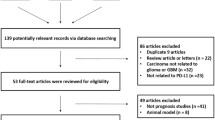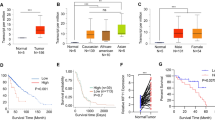Abstract
Tripartite motif (TRIM) proteins are involved in tumorigenesis. Here, we examined the expression, biological function, and clinical significance of tripartite motif containing 28 (TRIM28) in glioma, a locally aggressive brain tumor. First, TRIM28 expression was significantly higher in glioma (n = 138) than in non-glioma controls (n = 6). TRIM28 expression was positively correlated with tumor malignancy, and associated with poor overall survival (OS) and progression-free survival (PFS). Notably, TRIM28 expression was negatively correlated with p21 expression in patients with glioblastoma multiforme (GBM). A multivariate analysis that included relevant measures indicated that high TRIM28 expression is an independent prognostic factor for poor OS and PFS in GBM patients. In experiments with cultured glioma cells, down-regulating TRIM28 with shRNA increased p21 expression, and induced cell cycle arrest at the G1 phase. In a xenograft model, down-regulating TRIM28 suppressed tumor growth. These results indicate that over-expression of TRIM28 is associated with poor outcome in glioma patients.




Similar content being viewed by others
Abbreviations
- TRIM:
-
Tripartite motif
- TRIM28:
-
Tripartite motif containing 28
- OS:
-
Overall survival
- PFS:
-
Progression-free survival
- GBM:
-
Glioblastoma multiforme
- TMA:
-
Tissue microarray
- IHC:
-
Immunohistochemistry
- qRT-PCR:
-
Quantitative real-time polymerase chain reaction
- TCGA:
-
The Cancer Genome Atlas
- MIB-1:
-
Mind bomb E3 ubiquitin protein ligase 1
- KPS:
-
Karnofsky performance status
- MGMT:
-
O-6-methylguanine-DNA methyltransferase
- STR:
-
Subtotal resection
- GTR:
-
Gross total resection
References
Dolecek TA, Propp JM, Stroup NE, Kruchko C (2012) CBTRUS statistical report: primary brain and central nervous system tumors diagnosed in the United States in 2005–2009. Neuro-oncology 14(Suppl 5):v1–v49
Stupp R, Mason WP, van den Bent MJ, Weller M, Fisher B, Taphoorn MJ, Belanger K, Brandes AA, Marosi C, Bogdahn U, Curschmann J, Janzer RC, Ludwin SK, Gorlia T, Allgeier A, Lacombe D et al (2005) Radiotherapy plus concomitant and adjuvant temozolomide for glioblastoma. N Engl J Med 352(10):987–996
Weissman AM (1997) Regulating protein degradation by ubiquitination. Immunol Today 18(4):189–198
Koepp DM, Schaefer LK, Ye X, Keyomarsi K, Chu C, Harper JW, Elledge SJ (2001) Phosphorylation-dependent ubiquitination of cyclin E by the SCFFbw7 ubiquitin ligase. Science 294(5540):173–177
Onoyama I, Tsunematsu R, Matsumoto A, Kimura T, de Alboran IM, Nakayama K, Nakayama KI (2007) Conditional inactivation of Fbxw7 impairs cell-cycle exit during T cell differentiation and results in lymphomatogenesis. J Exp Med 204(12):2875–2888
Tsunematsu R, Nakayama K, Oike Y, Nishiyama M, Ishida N, Hatakeyama S, Bessho Y, Kageyama R, Suda T, Nakayama KI (2004) Mouse Fbw7/Sel-10/Cdc4 is required for notch degradation during vascular development. J Biol Chem 279(10):9417–9423
Reymond A, Meroni G, Fantozzi A, Merla G, Cairo S, Luzi L, Riganelli D, Zanaria E, Messali S, Cainarca S, Guffanti A, Minucci S, Pelicci PG, Ballabio A (2001) The tripartite motif family identifies cell compartments. EMBO J 20(9):2140–2151
Hatakeyama S (2011) TRIM proteins and cancer. Nat Rev Cancer 11(11):792–804
de The H, Lavau C, Marchio A, Chomienne C, Degos L, Dejean A (1991) The PML-RAR alpha fusion mRNA generated by the t(15;17) translocation in acute promyelocytic leukemia encodes a functionally altered RAR. Cell 66(4):675–684
Le Douarin B, Zechel C, Garnier JM, Lutz Y, Tora L, Pierrat P, Heery D, Gronemeyer H, Chambon P, Losson R (1995) The N-terminal part of TIF1, a putative mediator of the ligand-dependent activation function (AF-2) of nuclear receptors, is fused to B-raf in the oncogenic protein T18. EMBO J 14(9):2020–2033
Beer DG, Kardia SL, Huang CC, Giordano TJ, Levin AM, Misek DE, Lin L, Chen G, Gharib TG, Thomas DG, Lizyness ML, Kuick R, Hayasaka S, Taylor JM, Iannettoni MD, Orringer MB et al (2002) Gene-expression profiles predict survival of patients with lung adenocarcinoma. Nat Med 8(8):816–824
Landi MT, Dracheva T, Rotunno M, Figueroa JD, Liu H, Dasgupta A, Mann FE, Fukuoka J, Hames M, Bergen AW, Murphy SE, Yang P, Pesatori AC, Consonni D, Bertazzi PA, Wacholder S et al (2008) Gene expression signature of cigarette smoking and its role in lung adenocarcinoma development and survival. PLoS One 3(2):e1651
Ho J, Kong JW, Choong LY, Loh MC, Toy W, Chong PK, Wong CH, Wong CY, Shah N, Lim YP (2009) Novel breast cancer metastasis-associated proteins. J Proteome Res 8(2):583–594
Su LJ, Chang CW, Wu YC, Chen KC, Lin CJ, Liang SC, Lin CH, Whang-Peng J, Hsu SL, Chen CH, Huang CY (2007) Selection of DDX5 as a novel internal control for Q-RT-PCR from microarray data using a block bootstrap re-sampling scheme. BMC Genomics 8:140
Hou J, Aerts J, den Hamer B, van Ijcken W, den Bakker M, Riegman P, van der Leest C, van der Spek P, Foekens JA, Hoogsteden HC, Grosveld F, Philipsen S (2010) Gene expression-based classification of non-small cell lung carcinomas and survival prediction. PLoS One 5(4):e10312
Yokoe T, Toiyama Y, Okugawa Y, Tanaka K, Ohi M, Inoue Y, Mohri Y, Miki C, Kusunoki M (2010) KAP1 is associated with peritoneal carcinomatosis in gastric cancer. Ann Surg Oncol 17(3):821–828
Chen L, Chen DT, Kurtyka C, Rawal B, Fulp WJ, Haura EB, Cress WD (2012) Tripartite motif containing 28 (Trim28) can regulate cell proliferation by bridging HDAC1/E2F interactions. J Biol Chem 287(48):40106–40118
Liu B, Wang Z, Ghosh S, Zhou Z (2013) Defective ATM-Kap-1-mediated chromatin remodeling impairs DNA repair and accelerates senescence in progeria mouse model. Aging Cell 12(2):316–318
Mo LJ, Ye HX, Mao Y, Yao Y, Zhang JM (2013) B7-H4 expression is elevated in human U251 glioma stem-like cells and is inducible in monocytes cultured with U251 stem-like cell conditioned medium. Chin J Cancer 32(12):653–660
Jovcevska I, Zupanec N, Kocevar N, Cesselli D, Podergajs N, Stokin CL, Myers MP, Muyldermans S, Ghassabeh GH, Motaln H, Ruaro ME, Bourkoula E, Turnsek TL, Komel R (2014) TRIM28 and beta-actin identified via nanobody-based reverse proteomics approach as possible human glioblastoma biomarkers. PLoS One 9(11):e113688
Friedman JR, Fredericks WJ, Jensen DE, Speicher DW, Huang XP, Neilson EG, Rauscher FJ III (1996) KAP-1, a novel corepressor for the highly conserved KRAB repression domain. Genes Dev 10(16):2067–2078
Wang C, Rauscher FJ III, Cress WD, Chen J (2007) Regulation of E2F1 function by the nuclear corepressor KAP1. J Biol Chem 282(41):29902–29909
Rambaud J, Desroches J, Balsalobre A, Drouin J (2009) TIF1beta/KAP-1 is a coactivator of the orphan nuclear receptor NGFI-B/Nur77. J Biol Chem 284(21):14147–14156
Chang CJ, Chen YL, Lee SC (1998) Coactivator TIF1beta interacts with transcription factor C/EBPbeta and glucocorticoid receptor to induce alpha1-acid glycoprotein gene expression. Mol Cell Biol 18(10):5880–5887
Schultz DC, Ayyanathan K, Negorev D, Maul GG, Rauscher FJ III (2002) SETDB1: a novel KAP-1-associated histone H3, lysine 9-specific methyltransferase that contributes to HP1-mediated silencing of euchromatic genes by KRAB zinc-finger proteins. Genes Dev 16(8):919–932
Schultz DC, Friedman JR, Rauscher FJ III (2001) Targeting histone deacetylase complexes via KRAB-zinc finger proteins: the PHD and bromodomains of KAP-1 form a cooperative unit that recruits a novel isoform of the Mi-2alpha subunit of NuRD. Genes Dev 15(4):428–443
Santos J, Gil J (2014) TRIM28/KAP1 regulates senescence. Immunol Lett 162(1 Pt B):281–289
Lee YK, Thomas SN, Yang AJ, Ann DK (2007) Doxorubicin down-regulates Kruppel-associated box domain-associated protein 1 sumoylation that relieves its transcription repression on p21WAF1/CIP1 in breast cancer MCF-7 cells. J Biol Chem 282(3):1595–1606
Hoeller D, Hecker CM, Dikic I (2006) Ubiquitin and ubiquitin-like proteins in cancer pathogenesis. Nat Rev Cancer 6(10):776–788
Acknowledgments
This work was supported by China National Funds for Distinguished Young Scientists (81025013 to Ying Mao), National Natural and Science Foundation of China (81402053) and International Scientific and Technological Cooperation Projects (2014DFA31470 to Wei Zhu).
Author information
Authors and Affiliations
Corresponding authors
Ethics declarations
Conflict of interest
None.
Additional information
Zeng-Xin Qi and Jia-Jun Cai have contributed equally to this work.
Electronic supplementary material
Below is the link to the electronic supplementary material.
Rights and permissions
About this article
Cite this article
Qi, ZX., Cai, JJ., Chen, LC. et al. TRIM28 as an independent prognostic marker plays critical roles in glioma progression. J Neurooncol 126, 19–26 (2016). https://doi.org/10.1007/s11060-015-1897-8
Received:
Accepted:
Published:
Issue Date:
DOI: https://doi.org/10.1007/s11060-015-1897-8




